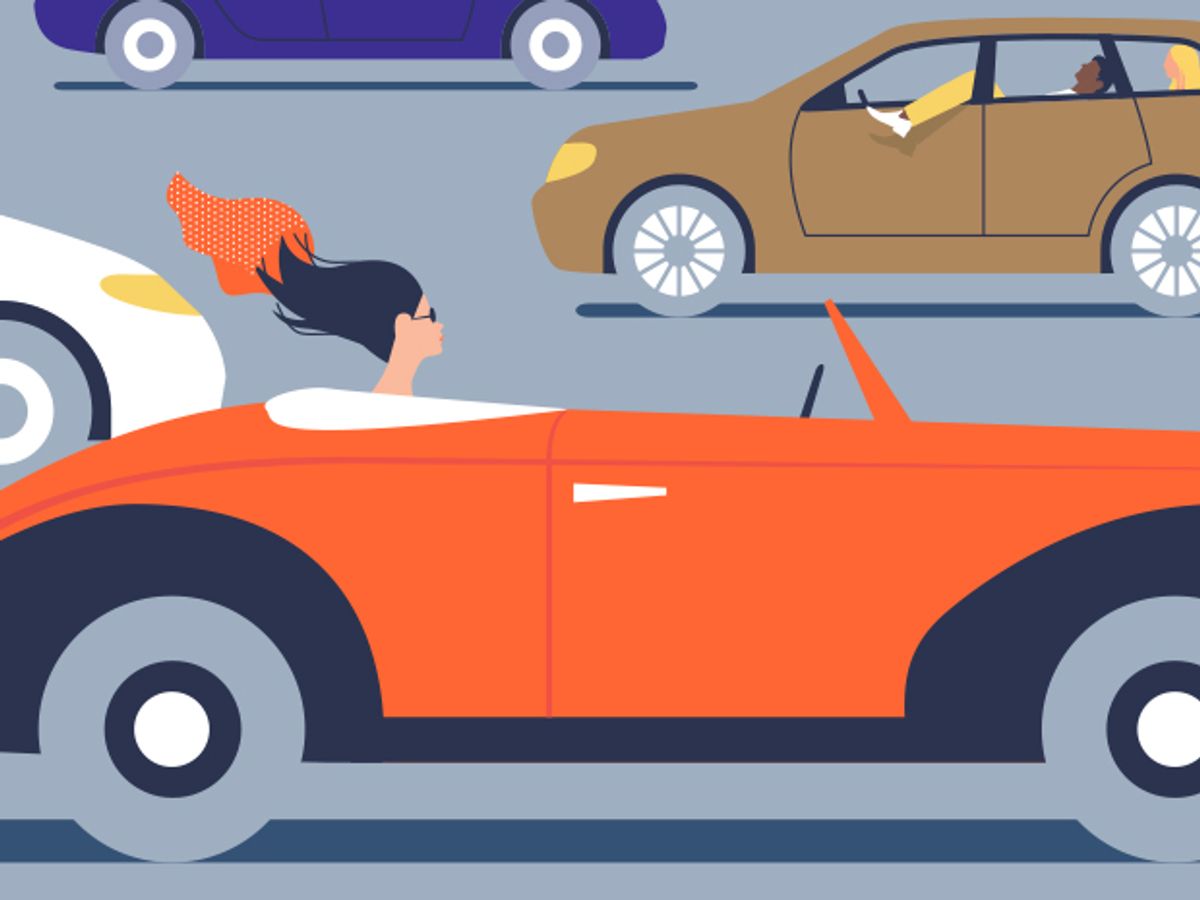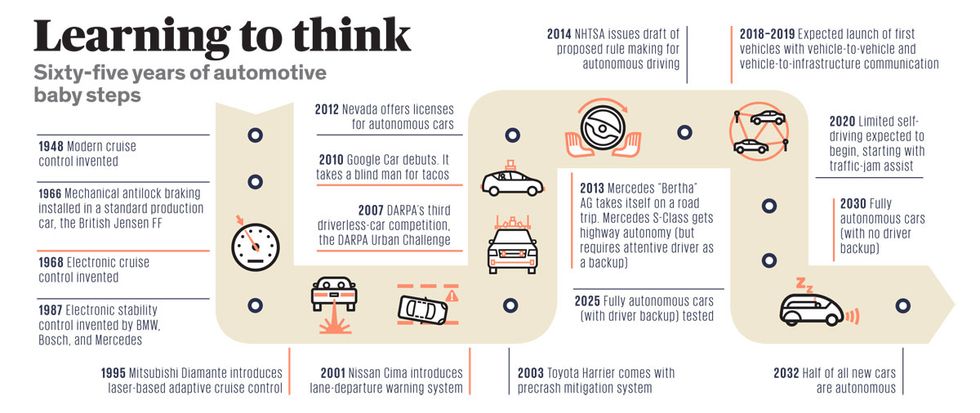Driverless Cars: Optional by 2024, Mandatory by 2044
Autonomous driving will push humans into the passenger seat

Sixty years ago this month, Isaac Asimov published a short story about a self-driving “automatobile” called Sally who had not only judgment but feelings, which spelled doom for the man who loved her.
It will happen—and it won’t. Fully automated cars will be common. Those cars will have judgment, and this will upend our lives, our work, and our cities. But cars will have no more feeling than IBM’s Deep Blue had back in 1997, when it beat the world chess champion. Well, two out of three isn’t half bad, even for an Asimov.
Today you can buy a top-of-the-line S-Class car from Mercedes-Benz that figuratively says “ahem” when you begin to stray out of your lane or tailgate. If you do nothing, it’ll turn the wheel slightly or lightly apply the brakes. And if you’re still intent on crashing, it will take command. In 5 years, cars will be quicker to intervene; in 20, they won’t need your advice; and in 30, they won’t take it.
Accident rates will plummet, parking problems will vanish, streets will narrow, cities will bulk up, and commuting by automobile will become a mere extension of sleep, work, and recreation. With no steering column and no need for a crush zone in front of the passenger compartment (after all, there aren’t going to be any crashes), car design will run wild: Collapsibility! Stackability! Even interchangeability, because when a car can come when called, pick up a second or third passenger for a fee, and park itself, even the need to own the thing will dwindle.“When we modeled that for Ann Arbor, Mich., we found we’d need only 15 percent of the cars now owned there,” for a per-mile cost savings of 75 percent, says Larry Burns, director of the Program on Sustainable Mobility at the Earth Institute of Columbia University, in New York City. Burns is no ivory-tower academic: In his previous job he headed up research and development for General Motors.
What’s most striking about the new thinking is how suddenly it jelled. Two MIT economists, Erik Brynjolfsson and Andrew McAfee, write about the switch in their recent book, The Second Machine Age, in which they describe their 2012 spin in the Google self-driving car as almost “boring” because the car drove “exactly the way we’re all taught to in driver’s ed.” They then note that the experience “was especially weird for us because only a few years earlier we were sure that computers would not be able to drive cars.”
Many others were just as sure. Read what Frank Levy of MIT and Richard Murnane of Harvard wrote about the challenge of city driving back in 2004, in their book The New Division of Labor:
As the driver makes his left turn against traffic, he confronts a wall of images and sounds generated by oncoming cars, traffic lights, storefronts, billboards, trees, and a traffic policeman. Using his knowledge, he must estimate the size and position of each of these objects and the likelihood that they pose a hazard…. Articulating this knowledge and embedding it in software for all but highly structured situations are at present enormously difficult tasks.
A year after those lines were written, Sebastian Thrun led the Stanford team’s car to victory in the DARPA Grand Challenge, the Defense Advanced Research Projects Agency’s autonomous vehicle race. Two years later, Google hired Thrun. And in 2010 Thrun’s group unveiled Google’s car.
Why the sudden change? Maybe it had to do with the ongoing drop in the cost of radar, infrared imagers, sonar, GPS, and other sensors. Or maybe it was the dramatic improvement in the processing power of embedded systems. Or it could be that engineers had just gotten comfortable with such building-block technologies as adaptive cruise control, automatic parking, and navigation.
In any case, by the beginning of this decade every major automaker was working on autonomous driving. The most in-your-face firm, as usual, is Nissan Motor Co., whose chief executive, Carlos Ghosn, recently promised to introduce not one car but a line of cars that can drive themselves—by 2020. Big talk, you may say, but in 2007 Ghosn vowed to deliver the all-electric Leaf by 2010, and he did.
Interesting, also, is Volvo’s growing investment in autonomous driving technology. As part of the European research project known as SARTRE (Social Attitudes to Road Traffic Risk in Europe), the final version of which ran from 2009 to 2012, Volvo supplied cars that automatically followed in a line behind a truck driven by a professional driver, saving effort and fuel.
A lead engineer in that project, Erik Coelingh, says Volvo is using a fleet of 100 cars to test out autonomy in the Swedish city of Gothenburg. Such validation will take time, he adds, no matter how fast other technologies may advance. “Even if you’ve tested the system in 10 cars and it works fine, with not a single incident, it doesn’t tell you a lot about how 100 000 cars will do on the road.”
He sees the technology advancing by degrees, beginning in test-bed cities like Gothenburg and in places where pedestrians aren’t allowed—say, within mines in Australia, where huge robotrucks are already carrying ore. Next come traffic jams, where movement is slow and there is no oncoming traffic. Then, he says, come selected routes, every meter of which has been carefully validated, so that a driver can just “punch a button to drive autonomously.”
Testing will proceed road by road and city by city, Coelingh says, building to the point at which cars can plan the route and take you there, from door to door. But he figures it’ll be 10 years for the first commercial robocars (that’s three more years than Ghosn predicts), and 20 before they take up a big share of new sales. However, he allows, autonomy could come faster in places where much of the infrastructure is only now being put in, like China. (By the way, Volvo is now owned by Geely Automobile, a Chinese firm.)
Where infrastructure is designed with robocars in mind, many of the hardest problems will be easy to solve. Cars will talk to the road, to the traffic signs, and to one another. What one car up ahead can see, all will know about. Even the problem of identifying pedestrians lurking behind shrubbery will finally fade away: After all, if cars can talk to signs, they can certainly talk to the cellphone in your pocket. Traffic accidents will be rare enough to be as shocking as they should be.
Asimov wrote not of robocars but of their consequences. He thus followed the sci-fi rule of his colleague, Frederik Pohl, “to predict not the automobile but the traffic jam.”
In that spirit, let’s assume that fully autonomous vehicles mature without worrying too much about the technology needed. What would happen? Briefly, our roads, our towns, and the frames of our lives will change, as they did when cars were first introduced.
“Approximately every two generations, we rebuild the transportation infrastructure in our cities in ways that shape the vitality of neighborhoods; the settlement patterns in our cities and countryside; and our economy, society, and culture,” writes Marlon G. Boarnet, a specialist in transportation and urban growth at the University of Southern California.
Robocars would be shared, and that would make them both convenient and cheap to use. Vehicles would be fewer in number but far more heavily used, picking up new passengers near where they left the last ones off. Such vehicle-sharing schemes are spreading, even though today’s dumb vehicles tend not to be there for you when you need them. One reason is that they accumulate at popular destinations. It’d be different for a car that could come when you called and leave when you were done with it.
“Certainly, car sharing is an option,” says Ralf Herrtwich, a leader in Mercedes’s autonomous car project, in Stuttgart. “Get the vehicle at your command, drop it at your convenience, no parking.”
Brave talk, but Mercedes owners must quail at the thought of a commodified sharemobile. Who would pay a higher fare for a robotaxi lined in burled walnut, with leather seats and a perfume dispenser—features actually offered in the 2014 Mercedes S-Class?
There’s one bunch who won’t be able to pay for such fripperies: professional drivers. Say good-bye to all of them—5 million people in the United States alone. In a world of autonomous cargo carriage, machines could hitch trucks to standardized containers of stuff. Then, at distribution points, other machines could transfer their contents to smaller trucks—or perhaps to robots so small they could safely roll along sidewalks. Picture a little triwheeler that would fail only by stopping, not by falling on your head, as one of Amazon.com’s proposed quadcopter delivery drones might do.
“Could we enter into a world where things are brought to us in a Segway-size pod?” wonders Burns of Columbia. “And if so, what does that do to retail big-box stores?”
Say bye-bye as well to the soccer mom. Parents will call a robocab, set its parental controls, lock the car doors, and send their teenage daughters to practice or maybe to the library, making it impossible for them to cruise “through the hamburger stand now,” as the Beach Boys sang in 1964.
The self-driving car will free us of much drudgery, true, but future generations may never know the freedom of the open road. And though the work such a car will do will be of great value, it probably won’t inspire many songs.
What Could Possibly Go Wrong?
When 99% Safe Isn’t Safe Enough
The dangers of autonomous-drive technology arise just as it approaches perfection
Illustration: MCKIBILLO
The worst thing that will accompany the march of robocar technology will come when cars are almost but not quite autonomous. Their prowess will lull all-too-human drivers into complacency.
“Automating the vehicle is a long continuum,” says Josh Switkes, founder and chairman of Peloton Technology, which is working on automating trucks. “If the driver doesn’t do anything most of the time but still has to do emergency braking? That’s not good. He doesn’t pay attention—he’s not there when you need him.”
To stop that from happening, this year’s Mercedes S-Class car actually sounds an alarm if the driver’s hand leaves the wheel for more than 10 seconds. Expect such backseat driving to get worse as self-driving technology gets better.
A second problem will be the eye-catching nature of the few accidents that do happen when cars routinely speed along with a 2-meter gap between them. In that world, anything that goes wrong for one car will go wrong for a lot of cars, and nobody will heed those who cite the statistics showing that driving is safer than walking. We know this will happen because it already has—for air travel.
There will be other little problems. The early robocars will be tuned to “extra polite,” allowing aggressive human drivers to practically run them off the road. Lawyers will have a field day when something goes wrong. And the very connectedness of cars—to one another and to the roads and signage—will take away the anonymity of the passengers. You’ll never drive alone—even if you want to.
Even the cities, relieved of most of their burden of cars, will also miss the revenue from parking fees. And public-transit systems, like subways, will suffer for lack of business.
But really, the worst single thing that could happen is that the autonomous car might not happen fast enough—not until the very end of the forecasting horizon of this special issue of IEEE Spectrum.
“Really automatic, as for a blind driver? Fifty years,” says Jens Desens, a Daimler engineer who works on his company’s experimental autonomous car and ought to know. He waves both hands for emphasis, which he can do because the car is doing all the driving.
We’re outside Stuttgart, cruising along an autobahn in a Mercedes S-Class tricked out with extra sensors. Unlike the experimental version, it can’t handle city streets, but it sure knows how to pass a slowpoke on a highway.
“Come on,” I sputter, after just such a demonstration. “If this car can do this now, what won’t it be able to do in a decade?”
Desens sits back, his hands in his lap (of course), and sighs.
“Look, we started in the ’60s and ’70s last century to develop this radar,” he says with another sigh. “It was this big”—his hands spread way out again—“like three suitcases. We started to sell it only in 1999. So 25 years of development just for the radar sensor.” —P.E.R.
This article originally appeared in print as “Robot, You Can Drive My Car.”

